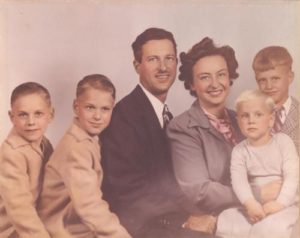Family Portrait Sonnet–a Sequence

An Ideal Shape and the 1950s
He lined us up in no conceivable
Arrangement, except a pyramidal
One, which is only just perceivable.
Our father’s smile is not a riddle;
He was a handsome, square-based man, and so
The group’s solidity depended on
Much more than smiles (though his were never slow)
And charm—yes, his was sprezzatura drawn.
Our eyes are drawn to him, not to the wave
In Helen’s hair or perfect childhood skin
On each photographer “touched up” face. Save
For one solemn blond, happiness is in.
..Iconic in its weight, the portraits speak
….One truth and they acknowledge nothing bleak.
Removed from the Sinister
(Second from the Left)
Pastel and false in various ways, the pic
Is truer than its maker meant. He thought
To make us perfect, 1950s slick.
Despite this sophistry, the vision caught
Tells truer truths than visual ones. Pastels
Are facts as much as undiluted hues,
And these four boys have yet to meet the swells
Atlantic storms could heave at them. The blues
Are grayed out carefully, but then what’s sad
Had not been visited upon us yet,
So why should sorrows be allowed to add
Their full intensity, their adult threat?
..That lovely Donald (cancer of the brain)
….Is not infected here with later stain.
Ivan Louis WhiddenIn the portrait Ivan has a distant |
What the Photographer Did Not See
There is a certain irony within
The carefully contrived composition.
One face is part obscured; that bit of chin
Is veiled from view. A blond apparition
Of glossy hair obtrudes beneath the smile.
Is that a prophecy? This partial face
Belongs to one who left the rank and file.
This man’s the one who’s found that holy place
In the twenty-first century’s media
Called cyberspace and garnered fame enough
To have a spot in Wikipedia
About him. He has called the picture’s bluff.
In fact the largest part of him is blocked
From view. The petty camera’s fault is mocked.
Donald Anthony Whidden
She holds me on her lap, embracing with
Her arm and hand my young boy ribs and blue
Pajamas. It’s become a monolith—
This portrait—packed with family meaning, true
Or not. My brother leans against his dad,
A cheek against that dark wool shoulder blade,
And father separates her from the sad
Resentment coded there, a barricade
Between the hidden hatred in the smile
That Donald gives and Helen with her hair
All twisted, a permanent set with bile
That son will carry on applying, bare
As any hatred known to mothers, sons
And families, till they are skeletons.
Brotherhood
I showed a black man in Nigeria
The most important picture in my life.
He works for rights and eleutheria [eleutheria=freedom]
Inside this nation stained with hate and strife.
So, certainly it came as no surprise
That he, unlike so many other bros,
Had sensitive, acute, non-racist eyes
Which made it easy, for him, to disclose
The portrait’s consequential details. He
Could see the good looks of my father, saw
(As others often don’t) which boy was me,
The whitely golden one without a flaw.
..Kadiri was enthusiastic, keen
….And sweet in insights as he viewed the scene.